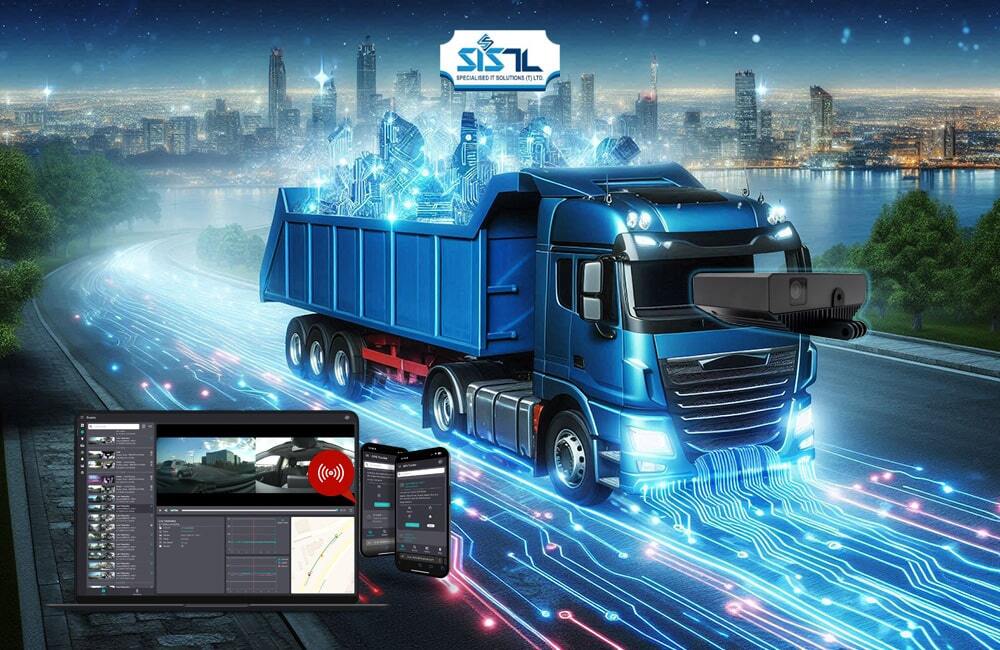
Tanzanian Trucking: How a Company is Conquering Challenges with AI-Powered Vehicle Camera Systems
Tanzania, a land of vast landscapes, bustling markets, and burgeoning industries, relies heavily on its trucking sector to keep its economic engine running. From the port city of Dar es Salaam to the agricultural heartlands and the mineral-rich regions, trucks are the lifeblood of the nation's supply chain. However, this crucial industry faces a unique set of challenges, ranging from road safety conces and fuel inefficiencies to cargo security and driver management complexities.
For years, trucking companies in Tanzania grappled with these issues, often relying on traditional methods that proved to be reactive rather than preventative. Accidents led to costly repairs, delays, and, tragically, loss of life. Fuel theft and unauthorized vehicle usage eroded profitability. Monitoring driver behavior and ensuring compliance with regulations remained a significant hurdle.
A prominent trucking company in the Tanzanian logistics landscape has a long-standing commitment to innovation and efficiency. Recognizing the limitations of conventional approaches, the trucking company embarked on a transformative jouey, embracing the power of AI and vehicle camera systems to revolutionize its operations and set a new benchmark for the industry.
This in-depth blog post explores how this trucking company strategically implemented AI-powered vehicle camera systems across its fleet, the specific challenges they addressed, the multifaceted benefits they realized, and the broader implications for the future of trucking in Tanzania.
Understanding the Challenges: A Landscape Ripe for Innovation
Before delving into the specifics of the trucking company's solution, it's crucial to understand the unique challenges that plague the Tanzanian trucking industry:
- Road Safety: Tanzania faces significant road safety challenges, with a high rate of accidents involving commercial vehicles. Factors contributing to this include driver fatigue, speeding, reckless driving, poor road infrastructure in certain areas, and the presence of mixed traffic (including pedestrians, cyclists, and livestock). Accidents lead to significant financial losses due to vehicle damage, cargo spoilage, insurance claims, and operational downtime. More importantly, they result in injuries and fatalities, impacting families and communities.
- Fuel Efficiency and Theft: Fuel costs represent a substantial portion of a trucking company's operational expenses. In Tanzania, fluctuating fuel prices and the risk of fuel theft pose significant threats to profitability. Traditional methods of monitoring fuel consumption often lack accuracy and real-time visibility, making it difficult to identify and address inefficiencies or instances of theft effectively.
- Cargo Security: The transportation of valuable goods across vast distances in Tanzania exposes cargo to the risk of theft and tampering. Ensuring the security of goods throughout the jouey is paramount for maintaining customer trust and preventing significant financial losses. Traditional security measures, such as seals and manual checks, can be vulnerable and lack real-time monitoring capabilities.
- Driver Management and Compliance: Managing a large fleet of drivers operating across diverse routes presents logistical and administrative challenges. Monitoring driver behavior, ensuring adherence to schedules and routes, and verifying compliance with traffic regulations and company policies can be complex and time-consuming using manual methods. Issues like unauthorized detours, excessive idling, and non-compliance can lead to inefficiencies and increased operational costs.
- Insurance Costs and Liability: The high accident rate in the trucking industry translates to higher insurance premiums for trucking companies. Proving liability in the event of an accident can also be challenging without clear and objective evidence.
- Operational Efficiency and Downtime: Any disruption to the smooth flow of goods, whether due to accidents, breakdowns, or logistical inefficiencies, results in costly downtime and delays. Minimizing these disruptions is crucial for maintaining operational efficiency and meeting delivery schedules.
Strategic Solution: Embracing AI-Powered Vision
Recognizing the limitations of traditional solutions in addressing these multifaceted challenges, the trucking company made a strategic decision to invest in cutting-edge AI-powered vehicle camera systems. This wasn't just about installing cameras; it was about implementing an intelligent, integrated solution that could provide real-time insights, proactively mitigate risks, and drive significant improvements across their entire operation.
The core of their solution involved the deployment of sophisticated multi-camera systems on their trucks. These systems typically included:
- Forward-facing cameras: Capturing the driver's view of the road ahead, providing crucial evidence in case of accidents and enabling the analysis of driving behavior.
- Inward-facing cameras: Monitoring the driver's actions and alertness levels, helping to identify instances of distraction, fatigue, or risky behavior.
- Side and rear-facing cameras: Providing a comprehensive view of the vehicle's surroundings, aiding in maneuvering, reducing blind spots, and capturing incidents occurring around the truck.
- Cargo bay cameras: Monitoring the security and integrity of the cargo during transit, deterring theft and providing evidence in case of tampering.
However, the true power of the trucking company’s solution lay in the integration of these cameras with advanced AI algorithms. This AI layer enabled the system to go beyond simple video recording and perform real-time analysis of the captured footage, identifying pattes, anomalies, and potential risks.
Key Features and Functionalities of the AI-Powered System:
- Advanced Driver Assistance Systems (ADAS): The AI algorithms analyze the forward-facing camera feed to provide real-time alerts to drivers about potential hazards, including:
- Lane Departure Waing (LDW): Detecting unintentional drifting out of lanes.
- Forward Collision Waing (FCW): Identifying potential front-end collisions and providing timely waings.
- Following Distance Monitoring (FDM): Alerting drivers when they are following too closely.
- Pedestrian Detection: Identifying pedestrians in the vehicle's path.
- Driver Behavior Monitoring: The inward-facing cameras, combined with AI-powered facial recognition and behavioral analysis, monitor driver actions for signs of:
- Distraction: Detecting phone usage, eating, or other activities that divert attention from the road.
- Fatigue and Drowsiness: Identifying micro-sleeps, yawning, and head movements indicative of fatigue.
- Risky Driving: Detecting aggressive acceleration, harsh braking, and sudden steering maneuvers.
- Fuel Efficiency Monitoring: By analyzing GPS data, engine performance metrics, and video footage (to identify excessive idling), the AI system provides insights into fuel consumption pattes and identifies areas for improvement. It can also detect anomalies that might indicate fuel theft.
- Cargo Security Enhancement: AI-powered video analytics applied to the cargo bay cameras can detect unauthorized access, tampering with seals, or suspicious activity around the cargo. Real-time alerts can be sent to the control center, enabling swift intervention.
- Incident Reconstruction and Analysis: In the event of an accident, the recorded video footage, combined with telematics data, provides a comprehensive and objective record of events. AI algorithms can assist in reconstructing the incident, determining the contributing factors, and assigning responsibility, streamlining insurance claims and legal processes.
- Real-time Alerts and Notifications: The AI system is configured to send real-time alerts to the drivers and the central monitoring team when critical events are detected, such as near misses, harsh driving events, or security breaches. This enables immediate intervention and corrective action.
- Data Analytics and Reporting: The system collects vast amounts of data on driving behavior, fuel consumption, and operational efficiency. This data is then analyzed and presented in comprehensive reports and dashboards, providing the trucking company’s management with valuable insights for making data-driven decisions, identifying trends, and tracking the impact of their safety and efficiency initiatives.
The Tangible Benefits Realized by the Trucking Company: A Transformation in Action
The implementation of AI-powered vehicle camera systems yielded a multitude of significant benefits for the trucking company, demonstrating the transformative potential of this technology in the Tanzanian trucking context:
- Significant Reduction in Accidents: The real-time ADAS alerts and driver behavior monitoring features proactively addressed the issue of road safety. Drivers received immediate feedback on risky behavior, leading to a demonstrable improvement in driving habits and a substantial decrease in the number of accidents. This not only reduced costs associated with accidents but also enhanced the safety of their drivers and other road users.
- Improved Fuel Efficiency and Reduced Fuel Theft: The AI-powered fuel monitoring system provided accurate insights into fuel consumption pattes, allowing the trucking company to identify and address inefficiencies such as excessive idling and suboptimal routing. Furthermore, the system's ability to detect anomalies helped to deter and identify instances of fuel theft, resulting in significant cost savings.
- Enhanced Cargo Security and Reduced Losses: The real-time monitoring of cargo bays through AI-powered cameras acted as a strong deterrent to theft and tampering. In the event of an incident, the clear video evidence facilitated swift investigation and recovery of goods, significantly reducing cargo losses and enhancing customer trust.
- Better Driver Management and Compliance: The AI system provided objective data on driver behavior, allowing the trucking company to identify drivers who needed additional training or support. It also helped ensure compliance with company policies and traffic regulations, reducing the risk of fines and improving overall operational discipline.
- Lower Insurance Costs and Reduced Liability: The clear video evidence provided by the camera systems proved invaluable in accident investigations, allowing the trucking company to accurately determine liability and streamline insurance claims. The demonstrable commitment to safety through the implementation of this technology also led to more favorable insurance premiums.
- Increased Operational Efficiency and Reduced Downtime: By proactively addressing safety issues, improving driver behavior, and enhancing security, the trucking company experienced a significant reduction in accidents, cargo losses, and operational disruptions. This translated to increased efficiency, improved delivery times, and enhanced customer satisfaction.
- Data-Driven Decision Making: The comprehensive data analytics and reporting capabilities of the AI system provided the trucking company's management with valuable insights into their operations. This data-driven approach enabled them to make informed decisions regarding driver training, route optimization, fuel management, and overall operational strategy.
- Enhanced Driver Accountability and Professionalism: The implementation of the camera system, coupled with transparent communication and training, fostered a culture of accountability among drivers. Knowing that their behavior was being monitored encouraged safer and more professional driving habits.
- Improved Company Reputation and Customer Trust: By demonstrating a strong commitment to safety, security, and efficiency through the adoption of advanced technology, the trucking company enhanced its reputation as a reliable and forward-thinking logistics partner. This strengthened customer trust and provided a competitive advantage in the market.
Overcoming Challenges in Implementation:
While the benefits were substantial, the trucking company likely faced certain challenges during the implementation process:
- Initial Investment Costs: Deploying sophisticated AI-powered camera systems across a large fleet involves a significant upfront investment.
- Infrastructure Limitations: Ensuring reliable connectivity for real-time data transmission in certain remote areas of Tanzania might have presented challenges.
- Data Privacy Conces: Addressing conces about driver privacy and ensuring compliance with data protection regulations would have been crucial.
- Driver Acceptance and Training: Some drivers might have initially resisted the implementation of camera systems. Effective communication, training, and highlighting the benefits for their safety and the company's success would have been essential.
- Technical Expertise and Support: Maintaining and troubleshooting the advanced technology would have required skilled technical personnel and reliable support.
The trucking company's success in overcoming these challenges likely involved a phased implementation approach, clear communication with stakeholders, investment in robust infrastructure, and a strong partnership with a reputable technology provider.
The Broader Implications for Trucking in Tanzania:
The trucking company's experience serves as a compelling case study for the transformative potential of AI-powered vehicle camera systems in the Tanzanian trucking industry. Their success demonstrates that embracing technology can provide effective solutions to long-standing challenges and drive significant improvements in safety, efficiency, and profitability.
The adoption of similar technologies by other trucking companies in Tanzania could lead to:
- A Safer Road Environment: Widespread use of ADAS and driver behavior monitoring systems could significantly reduce the number of accidents involving commercial vehicles, making Tanzanian roads safer for everyone.
- A More Efficient Logistics Sector: Improved fuel efficiency, reduced cargo theft, and minimized downtime would contribute to a more efficient and cost-effective logistics sector, benefiting businesses and consumers alike.
- Enhanced Competitiveness: Trucking companies that embrace technology and improve their operational efficiency and reliability will be better positioned to compete in the regional and inteational markets.
- Job Creation in the Technology Sector: The deployment and maintenance of these advanced systems will create new opportunities in the technology and logistics sectors.
- A More Sustainable Transportation System: Improved fuel efficiency and optimized routes can contribute to a more environmentally sustainable transportation system.
Looking Ahead: The Future of AI in Tanzanian Trucking
The jouey of the trucking company highlights the beginning of a technological revolution in the Tanzanian trucking industry. As AI technology continues to evolve and become more accessible, we can expect to see even more sophisticated applications emerging, such as:
- Predictive Maintenance: AI algorithms analyzing vehicle data to predict potential maintenance issues before they lead to breakdowns.
- Autonomous Driving Technologies: While still in early stages globally, the potential for autonomous or semi-autonomous trucking in the future could further revolutionize efficiency and safety.
- Integration with Smart City Infrastructure: AI-powered systems could integrate with smart city initiatives to optimize traffic flow and improve logistics planning.
- Advanced Route Optimization: AI algorithms analyzing real-time traffic data, weather conditions, and delivery schedules to dynamically optimize routes for efficiency and speed.
A New Era for Tanzanian Logistics
The trucking company's successful implementation of AI-powered vehicle camera systems marks a significant milestone in the modeization of the Tanzanian trucking industry. By embracing innovation and leveraging the power of artificial intelligence, they have not only solved critical operational challenges within their own organization but have also set a powerful example for the entire sector.
Their story demonstrates that technology is not just an expense but a strategic investment that can yield substantial retus in terms of safety, efficiency, profitability, and reputation. As Tanzania continues its economic growth trajectory, a mode, safe, and efficient trucking sector will be crucial for its continued success. The adoption of AI-powered solutions, spearheaded by companies like the trucking company, paves the way for a new era of logistics in Tanzania, one driven by intelligence, efficiency, and a commitment to safety for all. The road ahead is paved with possibilities, and AI is undoubtedly the key to unlocking a brighter future for Tanzanian trucking.
6+
Years OfExperience
Connecting You To Smarter Solutions
Empower your fleet with revolutionary IoT solutions. Gain valuable insights from on-board footage with our AI vehicle camera. Optimize operations with real-time GPS vehicle tracking system. Enhance communication with instant Push-to-Talk functionality for your team, wherever they are.


Subscribe to our Newsletter
For the latest insights on AI Vehicle Cameras, GPS Tracking Solutions, Push-To-Talk technology, and exclusive industry updates







Post a comment